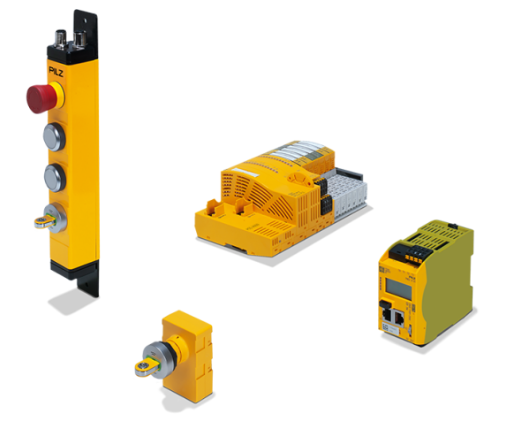How to ensure the safety of personnel in the danger zone in the shutdown state? The “pocket key” solution from Pilz prevents unintentional restarting of machinery until the person leaves the danger zone.
Before entering the safety protection area through the safety door, the operator (or several) needs to use the “personal key” to authorize and identify the PITreader device on the side of the safety door. is “checked in” to the control system (PNOZmulti2 or PSS4000). The mechanical equipment is now in a shutdown state, and the safety of personnel is guaranteed. And this guarantee comes from the fact that the “personal key” information on the operator has been recorded. To put the mechanical equipment back into operation, all operators must use their own “personal keys” to perform the “check out” operation, ensuring that each operator has left the danger zone.

The “pocket key” protection function is implemented using function blocks/modules in the Pilz controllers “PSSu PLC” (PSS 4000) and “PNOZ m B1” (PNOZmulti 2).
The function is introduced as follows:
A.Key-in-pocket block pocket key function block
1. Connection to the corresponding PITreader. The number is limited: (PNOZ m B1: <= 4, PSS u PLC: <= 10).
2. Configure the minimum permissions required to “check in” in the login list. Access to unauthorized persons can be restricted in this respect.
3. The input confirmation of the LED button, so as to realize the “check in” and “check out” process.
4. Input of “Checkout Condition” (for blind spot check). When it is necessary to realize the application of the blind spot inspection function, after the blind spot inspection is executed, an input signal is given to the input point.
5. Output of “enable (list is empty)” and “activate blind spot”. Output condition for whether the device can be restarted.

B.Blind spot check block Blind spot check function block
To ensure that no one is in the unseen area, the “Blind Spot Check” function can be configured.
This means that the last person to “check out” has to double-check the out-of-sight location to confirm that the blind spot area is clear. (via button and/or assigned PITreader).
This function is combined with a timer (minimum 30s) time, so the operator must complete the “check out” procedure within a certain time.
The function can also be cascaded, i.e. multiple “blind spots” can be run and confirmed.

C.Delete Safe Sign In List block Delete safe sign in list function block
If an operator cannot find his personal key after “checking in”, or if an operator has “checked in” and takes his personal key home, the system must be restarted by deleting the secure check-in list.
People with defined minimum privileges can perform this list deletion. The other requirement is that the person is also registered on the secure login list.
When the check-in list is deleted, the system remains in the state that the last operator has “checked in” and then the “check out” process must be performed again.
(Operators may still need to perform blind spot checks).

List of advantages
- Personnel identification and protection against unexpected device restarts
- Certification level: ISO13849 Pld Cat.3, IEC62061 SIL CL2, IEC 61508 SIL 2
- Complete record of information. Who entered which device at which time, how long they stayed and other information are fully recorded.
- If the identity key is lost, it can be quickly shielded through the program
- Can record up to 20 people to enter the interior of the mechanical equipment at the same time
- According to ISO 13849-1 5.2.2 requirements for “blind spot detection” manual reset function
- Different security door checkout functions can be realized
Application example 1: Robot workstation
Know who’s in the unit at all times, and audit usage logs for clear insight into the past. It can also clearly recognize who has the authority to operate which processes.
In applications with blind spot areas, before the system is restarted, the last operator is “forced” to confirm whether there is a person staying in the blind spot area.
Application example 2: Intralogistics/warehousing
When personnel enter the storage system, the control system prevents the risk of personnel interception.
The exit at the end of the aisle provides a “check out” function.
Prevent unauthorized access to automated storage and retrieval systems.






